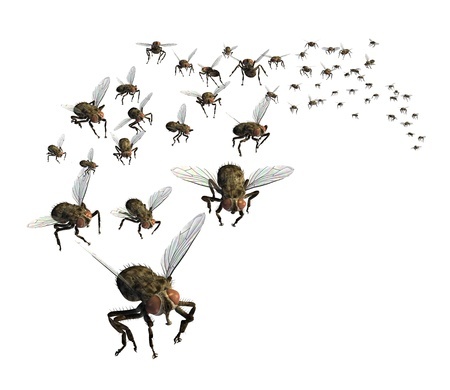More than 100,000 insect species belong to the Diptera order, including house flies, gnats, mosquitoes and all other two-winged insect species. All fly species that live in close association with humans and breed in rotting organic matter like excrement, carrion, and garbage are aptly known as “filth flies.” The most commonly controlled filth fly pests of homes include house flies, fruit flies, drain flies, phorid flies and blow flies. Generally, filth flies breed in outdoor sources of decaying organic matter, such as manure, lawn clippings, rotting food in garbage bins, and compost piles.
Naturally, homeowners are not tolerant of living in conditions where rotting organic matter is present, whether flies are breeding on them or not. However, it should be known that even sanitary homes harbor more than enough breeding sites where fly eggs can successfully develop into adults. For example, drain flies and phorid flies often lay eggs on the tiny bits of scum that collect in between kitchen tiles, and house flies and fruit flies can lay thousands of eggs on little bits of food that accumulate beneath appliances. House flies and fruit flies also commonly breed on rotting food in kitchen garbage receptacles, and blow flies breed on dead rodents that exist in the wall voids of many homes. No matter how well homeowners manage potential fly breeding sites indoors, flies will always invade homes. The three factors that motivate flies to invade homes include temperature, lighting, and food and filth odors.
Fly invasions can be influenced by seasonal changes, and this is especially true when there is a distinct temperature difference between indoor and outdoor locations. Filth flies detect cool air emanating from homes on excessively hot days, and warm air emanating from homes on cool days. In order to escape disagreeable outdoor conditions, filth flies enter homes through points where they can detect cool or warm air leaking from homes. These points include open doors and windows, gaps around door and window frames, and cracks and crevices on exterior walls. Many filth fly species are attracted to artificial lighting on porches and within homes, and all filth flies are highly capable of detecting agreeable odors like pet excrement, compost piles, and rotting food in outdoor garbage cans. Before flies invade homes, large numbers are usually lured into yards by white lights and agreeable odors. Replacing white light bulbs with yellow-hued LEDs has proven effective at reducing fly populations around homes, and keeping garbage and compost in tightly sealed bins and regularly removing pet excrement from yards will make properties less appealing to filth flies. Maintaining tight-fitting screens, and sealing cracks and other potential entry points on exterior walls will deny filth flies entry into homes.
Have you taken the time to pinpoint and seal all potential insect pest entry points on your home’s exterior walls?

